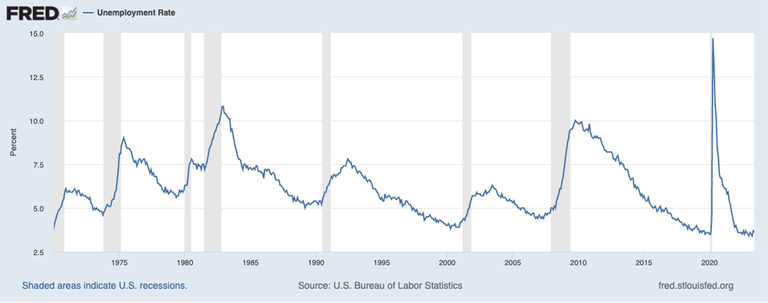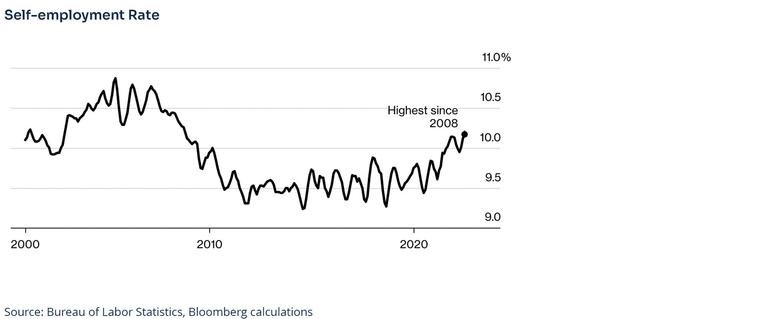Jobs 101 (Part Two): 7 Key job market trends
Learn about 7 key job market trends—and why traditional metrics aren’t capturing offshoring, the green economy and underemployment.

The last decade plus has seen the dynamics of the labor market increasingly surprise and puzzle experts, analysts, business leaders and policymakers. From the “jobless recovery” of the 2010s—where a growing economy left the job market behind—to the resolute strength of the current job market in the face of high interest rates and a slowing economy, we see the job market failing to respond to macroeconomic trends and blunt shocks in the ways traditional metrics and conventional paradigms would predict.
Understanding the hidden and overlooked factors that impact the labor market offers vital insights into how the job market is functioning today—and that deeper contextual understanding makes the job market a more reliable and valuable proxy for broader economic forecasting.
External factors lead the job market to deviate from the business cycle
Part 1 of LinkUp’s Jobs 101 series covered the basic understanding of the job market, looking at classic market theory—supply and demand for labor work their way toward equilibrium through the mechanism of wages. This traditional understanding also sees the business cycle as the primary driver of the job market: A strong economy will drive a strong, tight job market; and a slowing, stagnant or contracting economy will produce looseness in the job market.
But this correlation has never been exact. Macro factors and underlying trends can have significant and often under-appreciated influence on the job market. The last several years have seen several major trends converging to produce more dramatic impacts on the U.S. job market. Each of these factors influences the job market on its own—but these factors affect each other as well, creating an increasingly complex web of forces on the job market.
Technological Innovation & Disruption
Tech innovation has always played a disruptive role in the job market. The steam engine, for example, drove an extraordinary reduction in the demand for human-powered manual labor across every sector of the economy. Today, mechanization continues to reshape the job market—joined by computers and increasing computing power, robotics and automation, and now artificial intelligence—enabling businesses to produce more with less labor.
The increased efficiency of a disruptive tech innovation typically leads to a short-term dip in labor demand—a dip that has nothing to do with the business cycle. In fact, tech innovation is generally a boon to businesses, driving higher productivity and profitability. Disruptive tech also shifts the labor demand to new areas, and creates entirely new types of demand. In fact, a recent article from Goldman Sachs points out that 60% of U.S. workers today have jobs that did not exist in 1940.
The labor supply takes time to respond to changing demand. Tech innovation subtly shifts skill requirements, necessitating upskilling and reskilling in the workforce. And while tech disruptions can displace jobs or entire businesses (think film development in the 2000s), the net number of jobs often bounces back as those same technologies create new opportunities for businesses. For example, as a firm leverages new tech to produce more or new types of products, they may reallocate labor demand from manufacturing to sales and marketing to help them move all that efficiently produced product.

Skills Mismatches
As alluded to above, tech advancement often shifts skill requirements for existing jobs, while leading to the creation of new jobs with completely new skill requirements. People need time to catch up with this shifting demand and to upskill and reskill—to obtain new training or go back to school to get a specialized degree. Educational and job-training institutions, as well, take time to develop and expand instruction in new and emerging areas.
This lag period, where the skills possessed by the available labor supply do not align with the skills demanded by employers, can produce higher unemployment along with higher job vacancy rates. These job market dynamics don’t necessarily correlate with the business cycle and can defy the standard understanding of how these metrics typically interact.

Demographic Changes
Demographic shifts, such as aging populations and changing workforce composition, have profound effects on the labor market. The retirement of the baby boomer generation in many countries is leading to a shrinking workforce and skill gaps in certain sectors. Additionally, increasing workforce diversity, including gender, ethnic, and cultural diversity, is shaping labor market dynamics and highlighting the importance of inclusive policies and practices.
The changing demographics of the U.S. population naturally play a major role in the qualities of the labor supply in the job market. Currently, the biggest demographic factor influencing the U.S. job market is the “graying” of the American workforce. As the baby boomer generation moves toward retirement, the U.S. Census Bureau reports that the median age of the population has gone from 30 in 1980 to 38.9 in 2022. BLS stats echo this, showing that the median age of the U.S. workforce rose from 39.6 in 2001 to 41.7 in 2021. The percentage of the US workforce who are over the age of 55 went from 13.1% in 2000, to 23.6% in 2020.
A rapidly aging workforce impacts the labor force participation rate, while also weighting the labor supply toward the more experienced (and higher priced) end. It also presents the oncoming challenge of the so-called Silver Tsunami—the wave of retirements that will hit in the coming decades—reducing the overall available supply of labor and leaving large skill gaps in many areas of the job market.
Age is just one demographic factor which impacts the job market. Workforce participation among women surged over the last several decades, increasing the overall labor supply. Women’s workforce participation also saw a larger drop during the pandemic than that for men, though it has since bounced back.

Gig Economy and Flexible Work Arrangements
Gig work has surged over the past several years. Accelerated by the pandemic, advances in technology and connectivity make gig work more seamless for workers, and new and better platforms more efficiently connect employers and gig workers. Estimates suggest around 8.5% of the U.S. workforce now participates in the gig economy.
The fuzziness in the size of the gig economy alludes to one of the primary issues as it relates to the broader job market: Traditional job market metrics—which intentionally leave out part-time workers and self-employed persons, and often exclude demand for part-time work—do not fully or reliably capture the impacts and dynamics of the growing gig economy
Yet it’s clear that the growing gig economy is changing job market dynamics in significant ways. Workers increasingly feel empowered by the opportunity to choose their own schedules and take greater control of income and work-life balance. Employers are shifting more work to project- or gig-based models. These changes have major implications on labor force participation, job openings and hiring rates, and challenge traditional understandings of job security, job quality, and worker protections.

Globalization
The most well-known job market impact of globalization is job offshoring: U.S. companies moving operations to other countries to take advantage of lower labor or operational costs or preferential regulatory or tax structures—and thus taking labor demand overseas with them.
Global competition often increases the adoption of job offshoring strategies, as it adds pressure to find cost-efficiencies, which can also include leveraging automation, reductions in the overall workforce, and other cost-cutting strategies that impact labor demand. On the flip side, globalization creates new business opportunities, driving growth and potentially increasing labor demand for U.S. companies. Foreign investment, too, can drive growth (and expand labor demand) in the U.S. job market. And globalization promotes the movement or migration of workers between countries, changing the size and makeup of the labor supply. Globalization also produces more complicated impacts, such as increased labor specialization in certain sectors or skill sets.
An overarching reality is that globalization increases the pace of change across the economy and the job market. Technological innovation, skill mismatches, and even the gig economy are closely interrelated with increasing globalization.

Environmental Sustainability
The growing awareness, focus and urgency regarding environmental sustainability continues to drive more sizable impacts on the economy and job market. The transition to a green economy increases labor demand in emerging sectors focused on renewable energy, clean technologies, energy efficiency, waste management, sustainable agriculture, and environmental conservation. And as businesses in every sector prioritize sustainable practices, labor demand is evolving to include new skill requirements in sustainability-related areas—from renewable energy systems, environmental sciences, and sustainable design and construction, to green finance and environmental policy.

Workforce Well-being
The last few years have seen a notable rising focus on workforce wellbeing, mental health, and work-life balance. The societal prioritization of workforce wellbeing (and changing definitions of job quality) is empowering workers to ask for more and to expect better working terms and conditions. It’s also leading some to voluntarily sit on the sidelines of the job market, rather than accept lower-quality labor demand—impacting the labor force participation rate.
Employers have been responding by improving benefits and compensation, as well as by reconsidering expectations and requirements that impact worker productivity. These changes affect essential employer equations around the cost of labor (the incremental cost to add labor) and labor demand (how much labor is needed to achieve a targeted level of productivity).

Why traditional job market metrics don’t capture external factors
The hidden, external factors discussed above account for much of the gap between conventional job market and economic forecasts and actual outcomes. But a big part of the problem is that traditional job market metrics fail to capture the complex, nuanced impacts of these external factors.
Overlooking Underemployment & Mismatches
Traditional metrics like the unemployment rate may not provide a complete picture of underemployment. Underemployment measures the percentage of workers who are currently employed, but would like to work more hours, as well as workers who are overqualified or underutilized in their current jobs. Unemployment also fails to fully capture mismatches between supply and demand, such as skills gaps or geographic imbalances. Understanding underemployment and skill mismatches is vital for understanding how efficiently and effectively the labor market is functioning. An underemployed workforce represents an underutilized supply, indicating less-than-optimal outcomes for both workers and businesses. But a low unemployment rate can often hide these vital signs of slack or inefficiency in the job market.

Too Broad
Traditional job market metrics are good for getting a high-level aggregate view of the job market at a national or even regional level. But this broad perspective can mask significant variations within more granular regions, industries, or other subgroups. The dynamics faced by different demographic groups, occupations, or geographic areas may not be fully captured, making it difficult to identify and address specific issues and disparities. For example, tech disruption often impacts certain sectors, job types and skill sets, leaving others untouched and/or increasing labor demand in some areas. Overly broad metrics won’t tell this nuanced story.
Not Capturing Job Quality
The most commonly cited job market metrics center on quantity—the number of jobs or workers available, for example. But this fails to account for important dimensions of job quality, such as wage levels, job security, benefits, and working conditions. Neglecting these aspects may lead to an incomplete assessment of the relative strength of the job market. Moreover, variations in job quality can explain why labor supply might not respond to demand—including things like lower labor participation rates, higher vacancy rates and slower hiring velocity. Job quality continues to play a larger role as workforce wellbeing becomes a more salient societal and cultural touchpoint.
Missing the Gig Economy and Informal Jobs
Most conventional job market metrics very intentionally leave out part-time jobs, self-employed workers, and other unregistered or informal (cash-based) job activity. As both worker expectations and technology evolve and expand the role of gig and non-traditional work, ignoring the gig economy will lead to an underestimation and a misunderstanding of the state of workers nationally and globally.

Reporting Lag & Sampling Bias
These final two issues are inherent structural limitations presented by the way traditional job market metrics are derived. Many of the key BLS statistics stem from phone surveys and other sampling activities. This methodology introduces biases—for example, underrepresenting certain regions or groups—that skew the accuracy of the metrics. Reports show that BLS sampling activities have seen declining response/participation rates, decreasing the sample sizes and increasing the risk of sampling bias. On top of that, the nature of the survey methodology creates a significant time lag in reporting job market analysis. Employers and job seekers are typically asked about activities in the recent past, and the time it takes to aggregate survey responses means that reports feature insights that may be a month or more old by the time they reach the public.
Addressing the various limitations and gaps presented by traditional job market metrics requires alternative or supplementary measures, expanding data collection efforts, and adopting a multidimensional perspective on measuring, understanding and making predictions about the job market. Leading experts and analysts increasingly lean on alternative job market data and more textured, real-time metrics to gain a more nuanced understanding of the dynamics of the job market so that they can shape more accurate forecasts, create better policies, and make more confident business decisions.
Jobs 101-Part 3: How the job market functions (and what causes dysfunction)
The third part of LinkUp’s Jobs 101 series dives into how the job market functions—on both a macro and micro level. The conventional notion of tightness is contrasted with a more modern understanding of job market liquidity, including a discussion of how barriers to liquidity impede the efficient functioning of the job market.
Insights: Related insights and resources
-
Blog
07.20.2023
Jobs 101: What is the job market?
Read full article -
Blog
06.26.2023
Part 3 | 2023 Job Market Insights: Exploring Job Listing and Layoff Patterns
Read full article -
Blog
07.18.2023
LinkUp X Revelio Labs: Do AI skills pay off?
Read full article
Stay Informed: Get monthly job market insights delivered right to your inbox.
Thank you for your message!
The LinkUp team will be in touch shortly.
